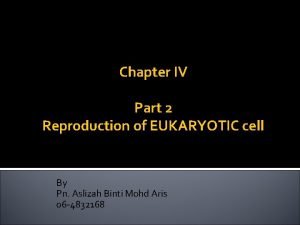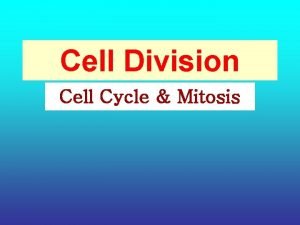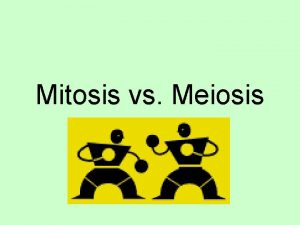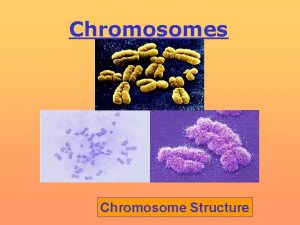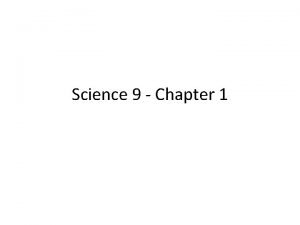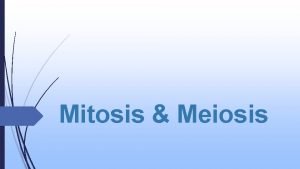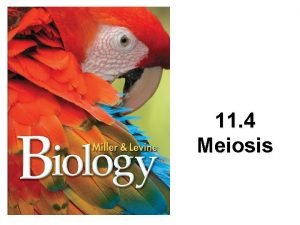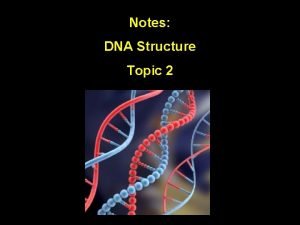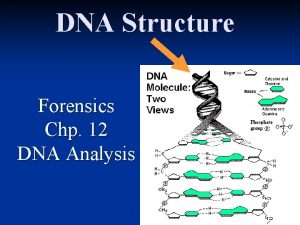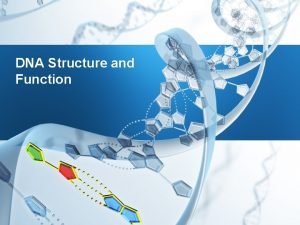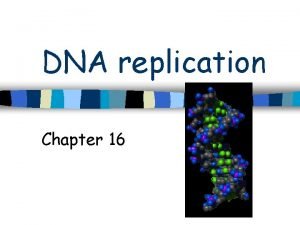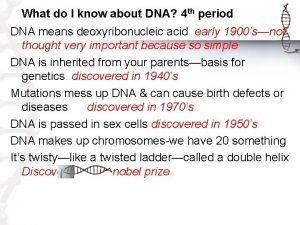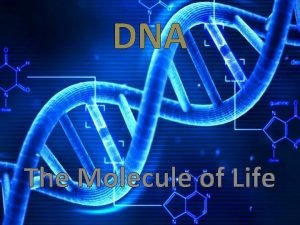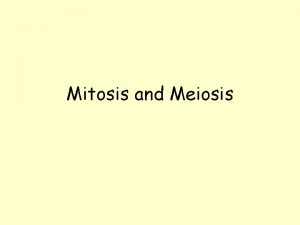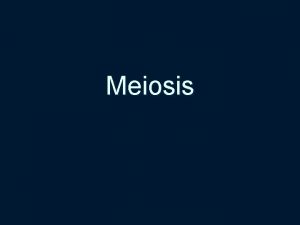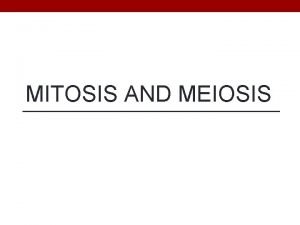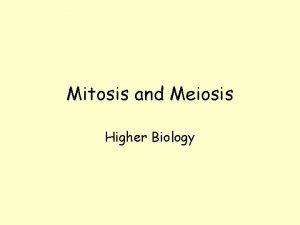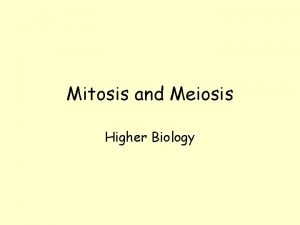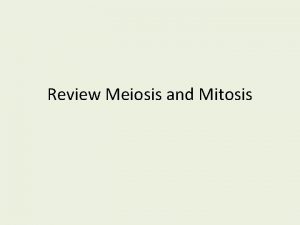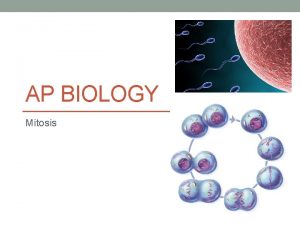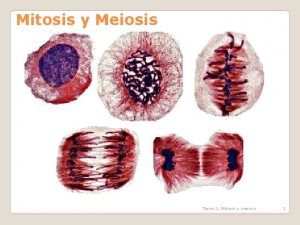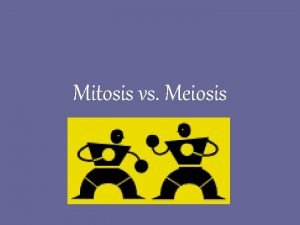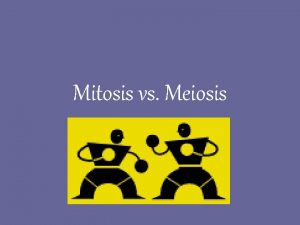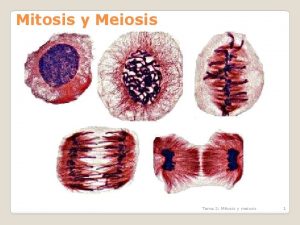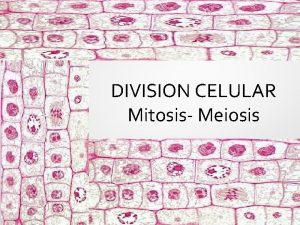Mitosis and Meiosis Chromosome a single DNA molecule
















- Slides: 16

Mitosis and Meiosis

Chromosome: a single DNA molecule complexed with histone proteins § DNA is organized within the nucleus as chromosomes § Each chromosome is comprised of subunits called nucleosomes: DNA + proteins

Chromosome numbering/naming § Chromosome numbering starts with the “largest” chromosome § Karyotype: a picture containing all the numbered chromosomes of a species Above: Zea mays (maize/corn) karyotype Left: Human female karyotype

Chromosome landmarks § Centromere § Arms § “Long (q) vs. short (p)” § Telomeres § Sister chromatids (after DNA replication in mitosis and meiosis)

Mitosis and Meiosis Mitosis Meiosis § 2 identical daughter cells (each 2 n) § 4 daughter cells (each n), which may be genetically different § All cells (potentially), zygote until death § Specialized cells (megaspore mother cell, pollen mother cell) Vv Vv V V v v Vv Vv

The cell cycle 1. Interphase a) G 1 (Gap 1): RNA and protein synthesis, but no DNA replication b) S (Synthesis): DNA synthesis. The total DNA content goes from 2 n to “ 4 n” c) G 2 (Gap 2): At this point, a diploid cell contains two complete diploid sets of chromosomes 2. M (Mitosis or Meiosis)

Mitosis example: Maize (2 n=2 x=20) § Prophase: Chromatin contracts. 1 chromosome = 2 sister chromatids. One strand in each chromatid is from the "original" chromosome, the other strand was made during the S phase (semiconservative replication). Chromatids are held together at centromere. § 20 sets of 2 sister chromatids = 40 chromatids. § Metaphase: Orientation of paired chromatids on Metaphase "plate". § 20 sets of sister chromatids aligned on plate = 40 chromatids.

Mitosis example continued: Maize (2 n=2 x=20) § Anaphase: Sister chromatids are pulled apart. § 20 chromatids migrate to each pole. § Telophase: Single chromatids, or at this point, chromosomes, return to the relaxed Interphase state. § Cytokinesis divides original cell into two daughter cells. § Two cells, each with 10 pairs of chromosomes = 20 chromosomes per cell. Maize : 2 n=2 x=20

Mitosis stages § Mitosis involves the creation of identical daughter cells. § These stages are part of a continuum – there are no abrupt stops or starts between the mitotic stages.

Meiosis stages § Meiosis is divided into two main phases Meiosis I and Meiosis II

Meiosis I Prophase I (5 stages) 1. Leptonema 2. Zygonema 3. Pachynema 4. Diplonema 5. Diakinesis Centromeres Telomeres

Meiosis I Prophase I - Zygonema 2. Zygonema: § Pairing of homologous chromosomes. § Formation of synaptonemal complex and additional DNA synthesis

Meiosis I Prophase I - Pachynema 3. Pachynema: Crossing over occurs (chiasma; chiasmata) § Bivalent = 2 paired homologous chromosomes = 2 sets of 2 chromatids

Meiosis I Metaphase I – Telophase I § Metaphase I: § Bivalents appear on the Metaphase plate § The random alignment of non-homologous chromosomes is the basis of independent assortment § Anaphase I: § The physical separation of homologous chromosomes is the basis of segregation § Telophase I. § Each pole receives one-half of the original chromosome number of the meiocyte (i. e. one set of chromosomes in the case of diploidy)

Meiosis II § Prophase II: § Chromatin condensation § Metaphase II: § Chromosomes align on the Metaphase plate § Anaphase II: § Sister chromatids go to opposite poles § Telophase II: § Cytokinesis: Tetrad of n daughter cells

By now you should be able to… 1. Draw a figure showing how two specific sequences of double stranded DNA are organized in a pair of homologous chromosomes. 2. Differentiate between mitosis and meiosis with regards to: § Start (parent cell) and end (daughter cells) § Timing: when in the life cycle of a plant does mitosis/meiosis happen? § Location: in what kind of cells does mitosis/meiosis happen? 3. Describe what happens in the S phase of Interphase, and in each phase of mitosis and meiosis. Remember to relate: § Metaphase I (Meiosis) random alignment of non-homologous chromosomes independent assortment of alleles in daughter cells. § Anaphase I (Meiosis) separation of homologous chromosomes segregation of alleles in daughter cells. 4. Describe the role of spindle fibers. 5. Define the terms: chromatin, centromere, homologous chromosomes, sister and non-sister chromatids, crossing over (or chiasma).
 Chromosome sets (=n) in mitosis and meiosis
Chromosome sets (=n) in mitosis and meiosis Anaphase meaning
Anaphase meaning Chromosome/mitosis/meiosis review answer key
Chromosome/mitosis/meiosis review answer key Prokaryotic chromosome vs eukaryotic chromosome structure
Prokaryotic chromosome vs eukaryotic chromosome structure Plant and animal reproduction venn diagram
Plant and animal reproduction venn diagram Venn diagram comparing mitosis and meiosis
Venn diagram comparing mitosis and meiosis Number of chromosomes in meiosis
Number of chromosomes in meiosis Dna bond structure
Dna bond structure Dna molecule two views
Dna molecule two views Ikatan hidrogen
Ikatan hidrogen Phosphodiester bond in dna
Phosphodiester bond in dna Molecule dna
Molecule dna Dna structure diagram
Dna structure diagram Griffith 1928
Griffith 1928 The molecule dna contains the four bases listed below.
The molecule dna contains the four bases listed below. Dna the molecule of life
Dna the molecule of life Whats the difference between mitosis and meiosis
Whats the difference between mitosis and meiosis
